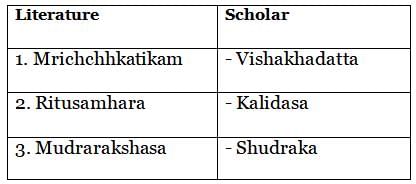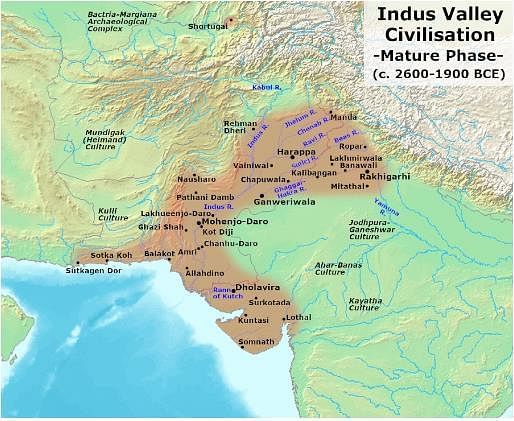GPSC Prelims Paper 1 Mock Test - 9 - GPSC (Gujarat) MCQ
30 Questions MCQ Test - GPSC Prelims Paper 1 Mock Test - 9
With respect to the history of the Ancient India, the terms such as ‘Ramapithecus’ and‘Sivapithecus’ were used to represent:
The illustrated manuscript of the Nimat Nama, a blend of Indian and Persian styles is a/an:
Which of the following neolithic sites was known for pit-house dwelling?
Consider the following statements regarding Firuz Shah Tughlaq:
1. He exempted Brahmans from the payment of Jizyah.
2. He took steps to have Hindu religious works translated from Sanskrit into Persian.
Which of the statements given above is/are correct?
With reference to the Pandya dynasty during the Sangam age, consider the following statements:
1. The Pandyas are mentioned by Megasthenes in his texts and highlighted the matriarchal influence on the Pandya society.
2. The Pandya territory occupied the southernmost part of the Indian peninsula, with its capital at Kaveripattanam.
Which of the statements given above is/are correct?
Arrange the following Harappan sites from west to east direction:
1. Dholavira
2. Nageshwar
3. Rangpur
4. Lothal
Select the correct answer using the codes given below:
Consider the following statements regarding the taxation system during Mahajanapadas:
- The tax on agriculture was fixed at 3/4th of what was produced.1.
- There were taxes on crafts persons2.
- There were also taxes on goods that were bought and sold, through trade.3.
Which of the statements given above is/are correct?
It is an important cave site having many images belonging to Vajrayana Buddhism. Buddhist caves are big in size and are of single, double, and triple storey. The Brahmanical caves have many sculptures and Ravana shaking Mount Kailash is one of them.
Which of the following cave sites is being described by the above-given passage?
Consider the following rulers:
- Antiochus II Theos of Syria
- Ptolemy III Philadelphus of Egypt
- Antigonus Gonatus of Macedonia
Q. How many among the above kings was/were contemporary to the Mauryan emperor Ashoka?
With reference to ziyarat in Sufism, consider the following statements:
1. It refers to the practice of pilgrimage to the dargah of the Sufi saint on his death anniversary.
2. The practice started during the times of Mughal rule in India.
3. The practice has direct relevance to the evolution of Qawwali.
Which of the statements given above is/are correct?
Consider the following statements regarding the Buddhist Sangha:
- The rules made for the Buddhist sangha were written down in Vinaya Pitaka.
- Slaves were prohibited from joining sangha.
Which of the statements given above is/are correct?
With reference to the King Harshavardhana of Vardhana dynasty, consider the following statements:
- King Harshavardhana was the founder of the Pushyabhuti Dynasty or the
- Vardhana Dynasty during the 7th century A.D.
- Fa-Hien, a famous Chinese traveler visited India during the Harshavardhana period and studied at Nalanda University.
- He defeated Chalukya king, Pulakesin II, and extended his kingdom beyond the Narmada river to the south.
Which of the statements given above is/are correct?
Consider the following statements regarding the Ashokan inscriptions:
- Prakrit, Greek and Aramaic languages were used
- The Aramaic and Greek scripts were used for inscriptions in Afghanistan.
Which of the statements given above is/are correct?
The Kalpasutra and the Kalakacharya- Katha, the two very popular texts belong towhich of the following sects?
Consider the following statements about Zabti and Dahsala system:
- Under the Dahsala system, the averageproduce of different crops, as well as theaverage prices prevailing over the last 10years, were calculated.
- The Dahsala system was the furtherdevelopment of the Zabti system.3
- The Zabti system is also known as TodarMal's bandobast.
Which of the statements given above is/arecorrect?
Which of the following sites used to be an important port of early Cholas?
Considered the following statements regarding Sangam literature:
- Tolkappiyam is a work on Tamil grammar authored by Tirukkural
- Silappathigaram was written by Sittalai Sattanar
- Manimegalai was written by Elango Adigal
Which of the statements given above is/are correct?
With reference to the teachings ofBuddhism, which one of the followingstatements is not correct?
Consider the following statements:
- Simuka was the founder of the Satavahana dynasty.
- King Hala authored the book Gathasaptasati in Prakrit.
Which of the statements given above is/are correct?
With reference to the Dhokra casting, consider the following statements:
1. It involves casting bronze through the lost wax method.
2. This technique is one of the most prominent metal crafts in the Bastar region of Chhattisgarh.
3. The metal craftsmen of Bastar are called ghadwas.
Which of the statements given above is/are correct?
Which of the following travellers had visited and written about the Vijayanagara Empire?
1. Domingo Paes
2. Fernão Nuniz
3. Niccolao Manucci
Select the correct answer using the code given below.
Consider the following statements with reference to Delhi Sultanate:
1. Delhi became the capital of a kingdom for the first time under Qutub-ud-din- Aibak.
2. Mongol attacks on the Delhi Sultanate increase during the reign of Qutub-ud- din-Aibak and ended forever during the reign of Iltutmish.
3. Mohammad Bin Tughlaq was the first ruler of the Tughlaq dynasty.
Which of the statements given above is/are correct?
In the context of the Mughal period, consider the following statements with reference to Ain-i-Akbari:
1. It was a book written by Abul Fazl in Indo-Persian style
2. The book contains both rules and regulations framed and put into effect for proper administration by Akbar and the social conditions that prevailed during his rule.
Which of the statements given above is/are correct?
Which of the following statements are correct regarding the Mughal paintings?
1. During the reign of Akbar, apart from depicting scenes from the Persian text of Mahabharata, the painters even drew
Persian fables and manuscripts.
2. Due to Indian influence on Mughal paintings, the flat two-dimensional effect of the Persian style was replaced by a three-dimensional effect.
3. Foreshortening technique of creating perspective was an indigenous innovation of the Mughal School.
4. As a trend in the Mughal school a single artist was used to commission an entire painting.
Select the correct answer using the code given below.
Consider the following pairs with reference to the cultural History of India :

How many pairs given above is/are correctly matched ?
Consider the following statements regarding the reign of Sultan Ghiyasuddin Balban of Delhi Sultanate:
1. He promoted people to important positions based on merit without discrimination between Turkish nobles and Indian Muslims.
2. He appointed spies to keep himself well informed.
3. He established the Diwan-i-amir-i-kohi (Department of Agriculture).
Which of the statements given above is/are correct?
Consider the following statements regarding the Nagara style of temple architecture:
1. In the Latina style of temple architecture the buildings are shorter and show a gentle rise as compared to phamsana type.
2. In many Nagara-style temples both phamsana and latina types of shikhara can be seen for manadapa and garbhagriha of a same temple respectively.
3. In the Vallabhi type of architecture buildings have a rectangular roof and are also known as wagon vaulted roofs.
Which of the above statements are correct?
In the context of the cultural heritage of India, which of the following items enjoy Geographical Indication status in India?
1. Aranmula Kannadi
2. Mysore Agarbathi
3. Hmaram
4. Dindigul Locks
Select the correct answer using the code given below.
With reference to Medieval texts, which of the following is/are not an autobiography ?
1. Tuzuk-i-Jahangiri
2. Ain-e Akbari
3. Qanun-i-Humayuni
Select the correct answer from the codes given below :




















